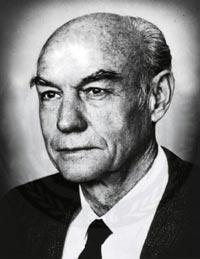Roger Wolcott Sperry (Roger Wolcott Sperry)

In 1942, Roger Wolcott Sperry began work at the Yerkes Laboratories of Primate Biology, then a part of Harvard University. There he focused on experiments involving the rearranging of motor and sensory nerves. He left in 1946 to become an assistant professor, and later associate professor, at the University of Chicago. In 1949, during a routine chest x-ray, there was evidence of tuberculosis. He was sent to Saranac Lake in the Adironack Mountains in New York for treatment. It was during this time when he began writing his concepts of the mind and brain, and was first published in the American Scientist in 1952. In 1952, he became the Section Chief of Neurological Diseases and Blindness at the National Institutes of Health and finished out the year at the Marine Biology Laboratory in Coral Gables, FL. Sperry went back to The University of Chicago in 1952 and became an Associate Professor of Psychology. He was not offered tenure at Chicago and planned to move to Bethesda, Maryland but was held up by a delay in construction at the National Institutes of Health. During this time Sperry’s friend Victor Hepburn invited him to lecture about his research at a symposium. There were professors from the California Institute of Technology in the audience of the symposium who, after listening to Roger Wolcott Sperry’s lecture, were so impressed with him they offered him a job as the Hixson Professor of Psychobiology. In 1954, he accepted the position as a professor at the California Institute of Technology (Caltech as Hixson Professor of Psychobiology) where he performed his most famous experiments with Joseph Bogen, MD and many students including Michael Gazzaniga.
Under the supervision of Paul Weiss while earning his Ph.D. at the University of Chicago, Roger Wolcott Sperry became interested in neuronal specificity and brain circuitry and began questioning the existing concepts about these two topics. He asked the simple question first asked in his Introduction to Psychology class at Oberlin: Nature or nurture? He began a series of experiments in an attempt to answer this question. Sperry crosswired the motor nerves of rats’ legs so the left nerve controlled the right leg and vice versa. He would then place the rats in a cage that had an electric grid on the bottom separated into four sections. Each leg of the rat was placed into one of the four sections of the electric grid. A shock was administered to a specific section of the grid, for example the grid where the rat’s left back leg was located would receive a shock. Every time the left paw was shocked the rat would lift his right paw and vice versa. Sperry wanted to know how long it would take the rat to realize he was lifting the wrong paw. After repeated tests Roger Wolcott Sperry found that the rats never learned to lift up the correct paw, leading him to the conclusion that some things are just hardwired and cannot be relearned. In Sperry’s words, “no adaptive functioning of the nervous system took place.” During Sperry’s postdoctoral years with Karl Lashley at Harvard and at the Yerkes Laboratories of Primate Biology in Orange Park, Florida, he continued his work on neuronal specificity that he had begun as a doctoral student and initiated a new series of studies involving salamanders. The optic nerves were sectioned and the eyes rotated 180 degrees. The question was whether vision would be normal after regeneration or would the animal forever view the world as “upside down” and right-left reversed. Should the latter prove to be the case, it would mean that the nerves were somehow “guided” back to their original sites of termination. Restoration of normal vision (i.e., “seeing” the world in a “right-side-up” orientation) would mean that the regenerating nerves had terminated in new sites, quite different from the original ones. The animals reacted as though the world was upside down and reversed from right to left. Furthermore, no amount of training could change the response. These studies, which provided strong evidence for nerve guidance by “intricate chemical codes under genetic control” (1963) culminated in Sperry’s chemoaffinity hypothesis (1951). Roger Wolcott Sperry later served on the Board of Trustees and as Professor of Psychobiology Emeritus at California Institute of Technology.
Born
- August, 20, 1913
- USA
- Hartford, Connecticut
Died
- April, 17, 1994
- USA
- Pasadena, California
Cause of Death
- Lou Gehrig's Disease


